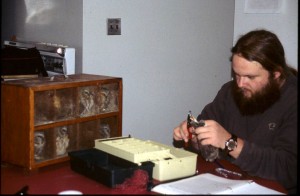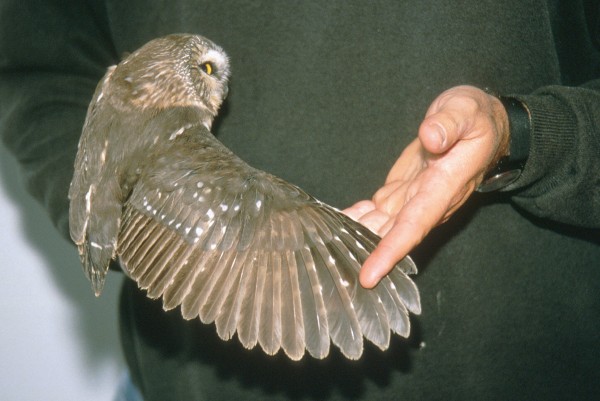15th year of sawwhet owl surveys! – results, history, significance
Effects of landscape composition on whip-poor-will abundance
January 4, 2009W&M and VCU agree to share CCB
January 6, 2009
Written by Bryan Watts
January 5, 2009

Northern saw-whet owl, one of the smallest owls in North America. Photo by Fletcher Smith.
In the fall of 1994, the Center for Conservation Biology launched a small project to investigate the migration of northern saw-whet owls on the lower Delmarva Peninsula. Prior to this time there were only 5 site records of the species along the Delmarva. The study began as the undergraduate honors project of David Whalen under the direction of Bryan Watts. The initial objectives were to investigate the magnitude and phenology of migration through the site, as well as the patterns of local distribution and movement. Three trap sites were established including one on the bayside of the peninsula (Kiptopeke State Park), one on the seaside of the peninsula (GATR Tract wildlife management area), and one on Wise Point (Eastern Shore of Virginia National Wildlife Refuge). Each site had an array of 6 nets and an audio-lure that played a continuous recording of a saw-whet advertising call. Dave Brinker (famed owl bander and founder of Project Owlnet) came down to the site and provided advice on the initial setup and design of equipment.

Saw-whet owls in holding boxes – a portion of the saw-whets collected in a single net check during the invasion year of 1995. A total of 122 birds were banded during the night of 17 November. Photo by Bryan Watts.

Fletcher Smith banding saw-whet owls in the field station at the Eastern Shore of Virginia National Wildlife Refuge. Photo by Bart Paxton.
During the first week of operation in 1994, the project captured more owls than had ever been recorded in Northampton County. During the 15-year study, more than 3,300 owls have been banded and more than 100 foreign recaptures and returns have been recorded. We have also recorded over 500 same-year recaptures. During the invasion year of 1995, the project processed more than 1,000 owls. During the invasion year of 1999, 695 birds were banded including the incredible night of 7 November when 174 captures were made. In addition to many new discoveries about saw-whet migration, the project has given many students and young researchers opportunities to experience migration research and has allowed the public the opportunity to see this secretive species.

Characteristic molt pattern of second-year northern saw-whet owl – new feathers are dark, older feathers that have not yet been replaced are lighter in color. Photo by Marian Watts.
The location of the lower Delmarva Peninsula along with the initial study design have together allowed for some new insights into the nature of saw-whet migration. Its geographic location near the southern range limit makes it very sensitive to the year to year variation in migration volume illuminating the irruptive nature of migration in this species. The bottle-neck nature of the peninsula along with the use of 3 trap sites has resulted in a tremendous rate of local recaptures that has allowed for a unique view of stopover ecology. The use of constant effort netting has allowed the project to examine patterns of movement across different temporal scales.

Northern saw-whet owl in hand. Photo by Shannon Ehlers.
Throughout the late 1990s, continuing through today, many trap sites have been established throughout North America to study the migration ecology of northern saw-whet owls under the umbrella of Project Owlnet. This network of banders now bands thousands of owls annually making it possible to answer questions about migration that could never have been considered in the past.

Project Owlnet Map of banding stations throughout North America that participate in Project Owlnet (red circles indicate the location of banding stations). Map by Project Owlnet.
Map of banding stations throughout North America that participate in Project Owlnet (red circles indicate the location of banding stations). Photo by Project Owlnet.
Project sponsored by the Center for Conservation Biology (CCB) with the U.S. Fish & Wildlife Service (USFWS), Va Dept. of Game & Inland Fisheries (DGIF), and the Va Dept. of Conservation & Recreation (DCR).



